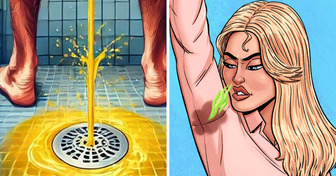10+ Moments People Discovered Their Partner’s True Colors

Your liver is essential for maintaining your body’s overall health — it detoxifies harmful substances, aids digestion, and supports metabolism. However, when your liver isn’t working well, it can impact many aspects of your health. Sadly, liver problems often remain hidden until they reach an advanced stage. Being aware of the warning signs is vital to safeguard your well-being. Here are six unexpected symptoms that may signal liver trouble, helping you take timely action and seek medical advice.
CONTENT IS PROVIDED FOR INFORMATIONAL PURPOSES ONLY AND IS NOT INTENDED AS A SUBSTITUTE OF MEDICAL ADVICE. SEEK GUIDANCE OF YOUR DOCTOR REGARDING YOUR HEALTH AND MEDICAL CONDITIONS.
Itchy feet can sometimes be a sign of liver disease, especially in conditions like primary biliary cirrhosis (PBC) and primary sclerosing cholangitis (PSC). These liver conditions cause damage or blockages in the bile ducts, leading to a build-up of bile in the body. This accumulation can cause severe itching, particularly on the hands and feet.
If your itching is due to a liver issue, you won’t see a rash or insect bites — just persistent itching. However, constant scratching can damage the skin over time.
The severity of the itching often matches the seriousness of the liver disease. You might notice the itching gets worse in hot conditions, like during a hot bath, at night, or when wearing certain clothes. The medical term for itching is pruritus.
A spider angioma, also known as a spider nevus, is a type of skin condition where small blood vessels just beneath the skin form a pattern that looks like a spider’s web. It usually features a red center with thin, reddish lines radiating outward.
These are quite common and harmless, appearing in about 10-15% of healthy adults and children. However, if you notice more than three of these spots, it could be a sign of something more serious, such as liver disease or hepatitis C (HCV).
Research indicates that the presence of spider nevi can help predict the severity of liver damage in individuals with chronic liver disease. In fact, these skin changes might be linked to the level of liver fibrosis, a condition in which the liver becomes scarred over time. So, spotting spider nevi could provide valuable clues about the progression of liver disease.
Reddening of your palms, also known as palmar erythema, is one of the warning signs you might need to pay close attention to. Palmar erythema, or “liver palms,” is a condition where the palms of the hands turn red, and in some cases, it can affect the backs of the hands, fingertips, nail beds, and sometimes even the soles of the feet.
Around 23% of people with liver cirrhosis experience this condition. It happens because of changes in hormone levels that affect blood flow, causing the blood vessels in the palms to dilate.
Palmar erythema can also appear in other situations, such as during pregnancy, with conditions like rheumatoid arthritis or diabetes, and in certain liver disorders like Wilson’s disease and hereditary hemochromatosis.
Hepatic encephalopathy (HE) is a condition where liver failure causes changes in consciousness. It can come on gradually or suddenly, and may include symptoms like difficulty with movement, mood swings, or shifts in personality. In severe cases, it can lead to a coma.
HE can happen in people with either acute or chronic liver disease. Triggers for episodes include infections, gastrointestinal bleeding, constipation, electrolyte imbalances, or certain medications. The main cause is thought to be a buildup of ammonia in the blood, a substance that the liver typically filters out.
There are a few mental signs to watch out for if you’re dealing with liver issues. You might:
When it comes to changes in behavior, you might not always notice them yourself. If you have long-term liver disease, experts advise asking your family and friends to keep an eye out for any changes in your mood or actions. Encourage them to be honest with you if they notice anything unusual, so you can stay on top of your health.
Terry’s nails is a condition where a person’s fingernails or toenails turn mostly white, giving them a “ground glass” look, with no visible moon-shaped area (lunula) at the base.
This change happens because of reduced blood flow and an increase in connective tissue in the nail bed. A key feature of Terry’s nails is that the white part of the nail fades when you apply pressure, which helps distinguish it from other conditions. Terry’s nails frequently occurs in the setting of liver failure, cirrhosis, diabetes, hyperthyroidism, or malnutrition.
80% of patients with severe liver disease have Terry’s nails, but they are also found in people with kidney failure, in patients with congestive heart failure, and are described as a brown arc near the ends of the nails. Terry’s nails can sometimes be a sign of aging, but if you notice this change in your nails, it’s important to check in with a healthcare provider for a proper evaluation and potential treatment.
Sometimes, people may notice a firm or unusual lump beneath the ribs on the right side of their body. This could be a sign of an enlarged liver or, in some cases, a tumor that is palpable through the skin. It’s important to understand that any persistent lump or swelling in this area should never be ignored.
If you detect such a lump, especially if it does not go away or grows over time, it is crucial to seek evaluation from a healthcare professional promptly. Early medical assessment can help determine the cause and ensure timely treatment if necessary.
While not every symptom indicates a serious condition, some warning signs from our bodies can reveal hidden health problems that are often overlooked. When it comes to your well-being, adopting a careful and proactive mindset is always the smarter choice.











